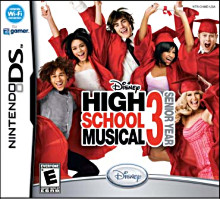| High School Musical 3: Senior Year | |
|---|---|
 | |
| Developer | Griptonite Games |
| Publisher | Disney Interactive Studios |
| Platform | Nintendo DS [1] |
| Release |
|
| Genre | Music video game |
| Modes | Single-player, Multiplayer |
High School Musical 3: Senior Year is a 2008 Nintendo DS video game based on the film released in October 2008. [1] There are all 29 songs all the 3 movies, and the player has to dance to them. The player can play as Troy, Gabriella, Sharpay, Ryan, Taylor or Chad, the main characters in the movie. [1]